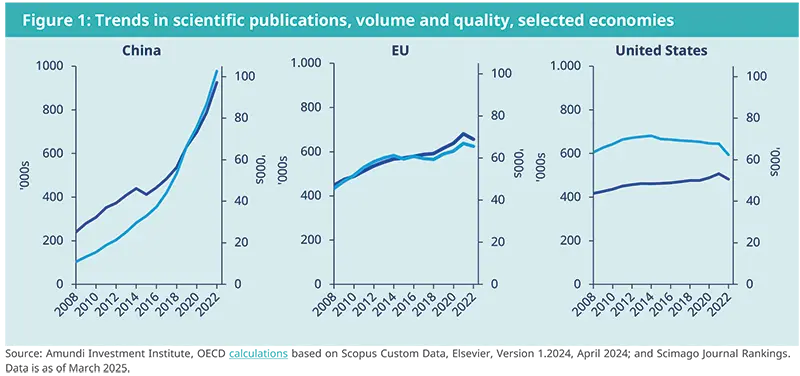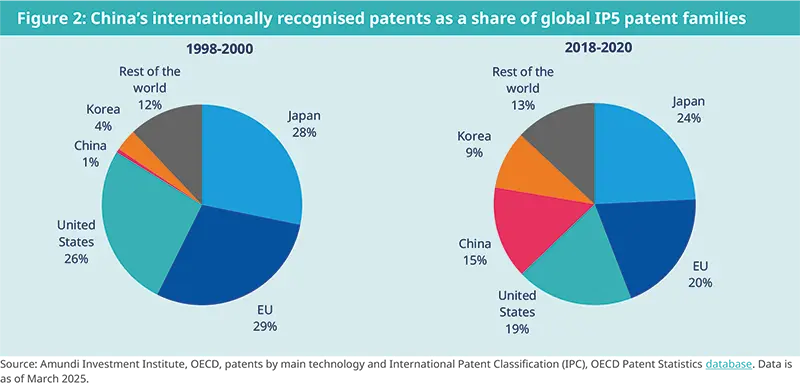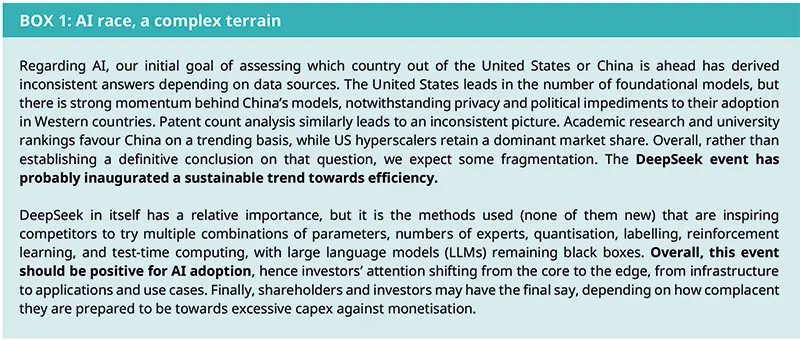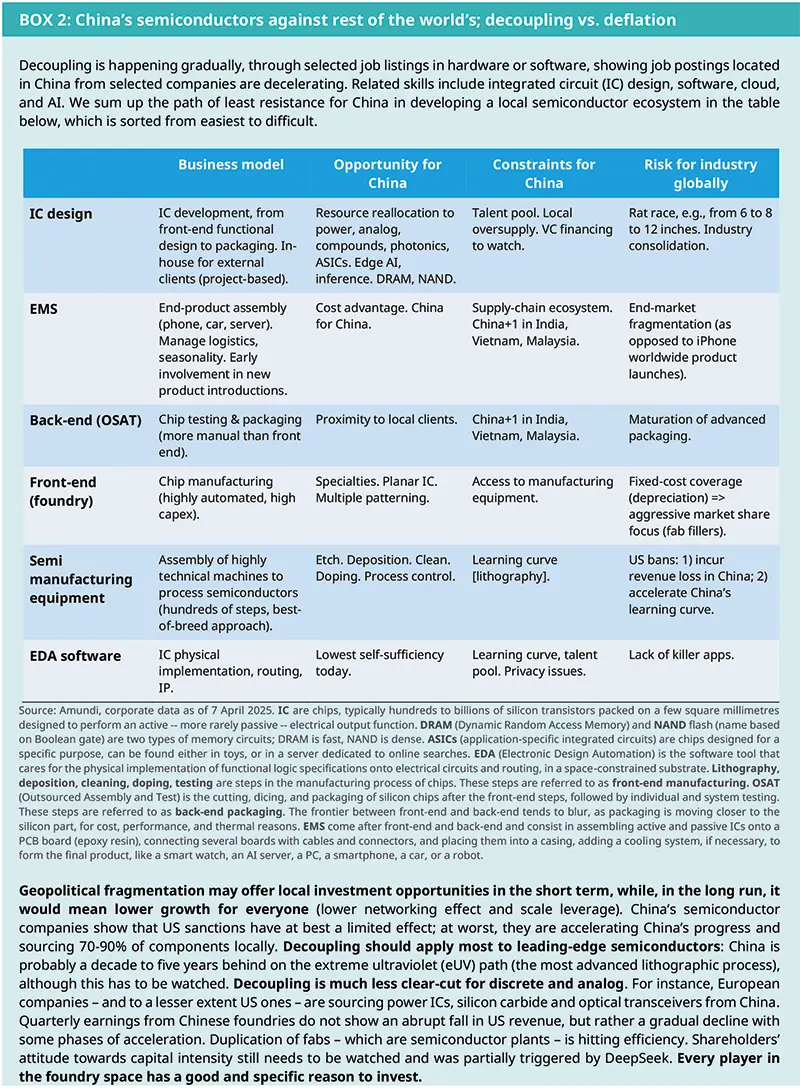Summary
Executive summary
With its rapid advancements in critical technologies, today, China is a formidable competitor to the developed West for global technology leadership. Innovation can take many forms, including process innovation – in which China excels – leveraging its large and dynamic manufacturing base. However, this is not enough. Technological progress also hinges on a nation’s ability to develop and spread innovation, to boost aggregate productivity and potential growth. On this, China’s innovation strategy has become increasingly centralised, with the government favouring specific sectors and systematically cracking down on others. A dynamic private sector and decentralised approach are essential for new technologies to spread and become accessible, fostering progress. In this respect, the environment for Chinese companies and institutions to innovate has deteriorated recently.
Today, the United States and its allies still hold significant advantages in capital markets and innovation ecosystems, while Chinese regulators crack down on the financial sector. For China to sustain its technological rise, it must prioritise final-demand innovation. While top-down, state-driven approaches have been effective in certain areas, they may not be sufficient to boost long-term growth. If China’s policies continue to stifle these market forces, its technological rise may plateau. China's future success will depend on whether it can balance its top-down, state-driven approach with the bottom-up forces of consumer demand and commercialisation.
Investing in Chinese tech leaders by selecting ‘scaling champions’ is a viable approach, considering the high barriers to entry created by their cost efficiency.
A strategic shift towards stimulating consumer demand is crucial to fighting deflation and sustaining China’s technological ascendancy. A failure to escape deflation may weaken the investment case for Chinese technology.
Currently, Asia commands the lion’s share in the production of sophisticated information technology hardware. Any attempt to relocate these supply chains to the United States would result in diminished profit margins, along with rising costs for consumers. Companies with higher pricing power and gross margins should better absorb the cost of reshoring, thus mitigating the risks associated with America First policies.
To sustain its technology leadership, China must balance state initiatives with market-driven innovation. A dynamic private sector is essential for new technologies to spread and foster progress
The misperception
Technology has been a battleground for superpowers for a long time. In 1969, the CIA concluded that the technological gap between the Soviet Union and the developed West was vast and widening. If the former maintained a centrally planned regime, it would never catch up with the West. Much has changed since then and the geopolitical landscape has shifted profoundly, yet the race for technological leadership among economic powers is more intense than ever. Today, the United States faces a new rival: China. With its rapid advancements in critical technologies, China is positioned as a formidable competitor to the developed West. In his recent report on Europe’s competitiveness, former ECB President Mario Draghi highlights how the Eurozone is competing directly with China in nearly 40% of the export sectors and has to close the innovation gap with China. In this paper, we explore China’s current standing in the global technological race, while addressing common misperceptions about its innovation capabilities. We examine the broader implications for global power dynamics and the challenges China faces as it strives for technological leadership.
The current discourse on China’s technological capabilities often falls into two extreme positions:
The sceptics’ view: some dismiss China's innovation capacity entirely, perceiving it as merely imitative. This perspective is outdated and disconnected from reality, having been challenged by Chinese advancements in electric vehicles (EVs), batteries, artificial intelligence (AI) and robotics.
The alarmist view: others portray China as being overwhelmingly dominant across the technological spectrum. The Australian Strategic Policy Institute reports Chinese leadership in 57 out of 64 critical technologies in 2019-23, including AI and quantum computing, while the United States leads in only seven areas. This view tends to overemphasise early-stage technological development, while neglecting implementation challenges and adoption.
Both perspectives – whether viewing China as a mere copycat or as an existential threat – fail to capture the complexities of its technological ascent. Sceptics often adopt a narrow definition of innovation, equating it solely with originality in design. However, innovation can take many forms, including process innovation, which is an important feature of China's innovation landscape. China excels in this regard, leveraging its large and dynamic manufacturing base to drive innovation through iterative processes. Thus, China’s emergence as a global innovation power is closely linked to its robust manufacturing capabilities and active participation in the global value chain.
However, one should not simply extrapolate from China’s past successes. Progress in technology hinges on a nation’s ability to both develop and diffuse innovation. Successful diffusion translates into productivity gains, a vital source of long-term growth in an era marked by an ageing population and high public debt. Yet, China’s innovation strategy has become increasingly centralised, with the government favouring specific sectors and systematically cracking down on e-commerce platforms, gaming and healthcare over the past three years. The anti-corruption campaign in the financial sector has also stifled capital allocation, forcing promising private companies to exit the market.
Global examples, including those from China, demonstrate that a dynamic private sector and decentralised approaches are essential for new technologies to proliferate and become widely accessible, ultimately fostering progress. Proper incentives for commercialisation must be established. Amid low consumer confidence, persistent deflationary pressures and increased scrutiny from abroad, the environment for Chinese companies and institutions to innovate has deteriorated. Considering these challenges, China is entering a phase in which the pace of its technological advancement is likely to moderate.
China’s rise in innovation
China’s technological ascent has been remarkable, particularly measured by scientific research publications and their influence, and the number of qualified patents.
Research capability
China has made significant strides in academic research. The Nature Index, which tracks high-quality research publications, shows that seven out of the top ten academic institutions globally are Chinese. This is a notable improvement from just a few years ago. In specific fields, such as chemistry (nine out of the top ten institutions) and earth & environmental sciences (eight out of ten), China is dominant. However, in corporate research, China lags, with no Chinese companies ranking in the top ten globally in 2024. In the QS University Rankings, China fares less favourably, although its top institution, Tsinghua University, ranks within the top 20 globally, excelling in computing sciences. The impact of academic research is often assessed through citation counts. In this respect, China overtook the United States in 2019 as the leader in the world’s top 10% most cited papers, and its lead has widened in the subsequent three years (see figure 1). In 2022, China produced 28.8% of the world’s total top 10% most cited publications, while the EU and the United States each accounted for less than 20%.

China’s ascent in international academic influence has historically been associated with an increase in talent exchanges among the global community, particularly through the presence of Chinese students and researchers in STEM (science, technology, engineering, and mathematics) fields at US universities. In 2018-19, Chinese nationals comprised 16% of all US graduate students. In the AI field, the United States and China had the greatest number of collaborations in publications in 2010-21 across the globe. With tightened US immigration and visa policies affecting Chinese students, accusations of espionage, and a narrowed renewal of the United States-China Science and Technology Agreement, cross-country collaboration should decline further, directly impacting China’s global academic influence. Since 2016, rising United States-China tensions have resulted in Chinese graduates becoming less likely to remain in the United States post-graduation and securing employment there, while Chinese researchers have significantly reduced their citations of US research1
Technology output
While R&D spending is often considered an important metric, it reflects primarily inputs rather than outcomes. In this analysis, we focus on patents as a more direct measure of technological output, as they provide a clearer indication of a country's innovation capabilities. China’s patent output has surged in recent years. In 2023, China surpassed the United States in total patent filings, with over 70,000 patents compared to fewer than 60,000 in the United States, according to the World Intellectual Property Organisation (WIPO). The data also reveals that China’s patent growth has been particularly strong in areas like batteries, biotechnology, machine learning and semiconductors. For instance, China has made substantial progress in DRAM memory, silicon carbide and quantum computing, fields where the United States once led (see Appendix).
Interestingly, in specific categories like OLED and batteries, the United States appears to have ‘thrown in the towel’, while China continues to accelerate. This shift suggests that China is not merely following in the footsteps of Western innovation, but is actively pushing the boundaries. Among internationally recognised patents, particularly within the IP5 patent families (a forum of the five largest intellectual property offices globally), China's share increased significantly from just 1% of the global total in 1998-2000 to 15% in 2018-20 (see figure 2). Notably, more than half of these patents originated from the information and communications technology (ICT) sector in 2020. To exclude completely China’s domestic bias that may favour local inventions, the OECD's triadic patent indicator – which considers patents jointly registered only with European, Japanese and US patent offices – reveals a steady increase in China's patent filings, reaching approximately 40% of the US level in 2021.

Technology diffusion
The accessibility of infrastructure, the adoption rates of key technologies among businesses, and the availability of skilled engineers are indicative of a country’s capacity for technology diffusion. However, no single analysis or measure can be exhaustive due to limitations in data availability, the unpredictability of technological advancements, and the challenges in determining which technologies are most critical for societal progress. China has a distinct advantage in developing affordable infrastructure, albeit at the cost of rising unproductive debt and local fiscal stress. The country boasts sophisticated logistics networks, a high penetration of digital infrastructure (with 1 billion 5G subscribers), relatively low costs for water and electricity, and affordable industrial land, all of which facilitate the adoption of new technologies.
Moreover, China produces the highest number of STEM graduates globally (4.7 million), followed by India (2.6 million) and the United States (0.6 million). The British industrial revolution in the 18th and 19th centuries illustrates how a skilled labour force could accelerate the adoption of new inventions, no matter where they originated2. As a result, China is in close competition with the United States in the adoption of key technologies. China leads in manufacturing automation, as evidenced by its robot density (units of robots per employee), yet it lags in the adoption of AI, with 24% of US organisations fully implementing generative AI technologies compared to 19% in China.
While the above indicators help illustrate the presence of technology, they neglect organisational behaviours, entrepreneurial spirit and political/institutional features that are crucial for driving technology diffusion. The Soviet Union, despite its talented scientists and significant R&D spending, struggled to translate technological advancements into widespread societal productivity. This failure was largely due to its centralised, bureaucratic approach to technology diffusion, which stifled adoption. This highlights how technology diffusion is a critical equivalent – if not more important – as technology advancements.

Technology diffusion is as critical – if not more important – as technology advancements.
Formula of success
In contrast to the Soviet Union, China has been far more successful in translating technological advancements into economic gains. For example, China's EV and semiconductor sectors have seen rapid growth and global competitiveness. China’s rise in technology has been significantly propelled by its dynamic private sector, which thrives in a manner that often contrasts with the country’s centralised political image. A prime example is Shenzhen, which has evolved from a fishing village into a bustling metropolis of migrants. Although the city has a relatively low percentage of highly educated workers compared to other major Chinese cities, it boasts the highest concentration of R&D personnel and is home to a few tech giants, which contribute substantially to China’s Information and Communications Technology (ICT) progress. This phenomenon highlights the effectiveness of a decentralised innovation ecosystem, where local governments allow for greater flexibility, and demonstrates how localised, business-friendly policies and a liberal labour market can foster technological advancement, even without top-notch talent.
The success of Shenzhen also challenges the notion that China’s centralised political system will inevitably lead to stagnation. Arguably, the room for local autonomy has been eroded in the aftermath of Covid-19. While China’s private sector has been a key driver of its technological ascent, several challenges remain that could impede the country’s progress:
Deflation: Persistent deflationary pressures pose challenges for profitability and technology adoption across both companies and institutions. In a cost-cutting environment, R&D and capital expenditure spending decline as companies focus on deleveraging to survive, leading to reduced investment in future growth. This deflationary cycle not only affects corporate profitability but also stifles innovation at both the institutional and societal levels, hindering overall productivity growth.
Domestic regulatory uncertainty: China’s unpredictable regulatory environment poses another significant challenge. The government’s Common Prosperity initiative, which aims to reduce income inequality, has led to crackdowns on sectors like e-commerce and education. These measures have dampened innovation and entrepreneurial spirit within the private sector. Companies in the technology, media, and telecom (TMT) sector, once seen as leaders of Chinese innovation, have faced significant regulatory hurdles since 2021.
Geopolitical tensions. China's relationship with the West, particularly the United States, is becoming increasingly strained. The Biden administration renewed the China-United States scientific research agreement with heightened restrictions that negatively impact cross-country academic cooperation and data exchanges. Chinese scholars in the United States face growing scrutiny due to national security concerns, and US export controls and sanctions have expanded to a wider range of high-tech goods, particularly in the semiconductor industry. The Trump administration has expanded the toolkit with the America First Trade/Investment Policy frameworks. Further restrictions on bilateral trade, talent and capital exchanges are likely.
Historically, sanctions have been effective in slowing technological progress. In the cases of Iran and Russia, sanctions have led to more militarised societies, and weakened their private sectors and middle classes. China may face similar outcomes if sanctions expand further. The Chinese government's increasing focus on military-civilian fusion suggests a more defensive stance in response to Western sanctions.

Path forward
The race for technological leadership between China and the West is far from over. While China has made significant strides, particularly in patent filings and scientific research, it faces numerous challenges, both geopolitical and domestic. The United States and its allies still hold significant advantages in capital markets and innovation ecosystems, while Chinese regulators crack down on the financial sector. For China to sustain its technological rise, it must prioritise end-demand innovation. While top-down, state- driven approaches have been effective in certain areas, they may not be sufficient to maintain long-term growth. If China’s policies continue to stifle these market forces, its technological rise may plateau.
Ultimately, the key to long-term technological leadership lies in a nation’s ability to commercialise and spread its innovations. As the Soviet Union's experience shows, technological discovery alone is insufficient for sustained growth. China's future success will depend on whether it can balance its top-down, state-driven approach with the bottom-up forces of consumer demand and commercialisation.
Investment implications
The United States hosts the world’s most efficient capital market that incubates pioneering innovators (from 0 to 1). Its single and unified market provides a fertile ground for enterprises to expand their scale with unparalleled ease. China has developed the world’s largest and most cost-efficient manufacturing sector. With its intricate and highly developed supply chains, it empowers companies to innovate through execution and scaling (from 1 to 100). Numerous Chinese manufacturers, with their ‘can-do’ spirit, produce goods that others often find economically unfeasible to replicate. Investing in Chinese tech leaders via selecting ‘scaling champions’ is a viable approach, considering the high barriers to entry created by their cost efficiency.
Although corporate China exhibits competitiveness across multiple domains, geopolitical tensions and deflationary pressures loom large, potentially undermining its profitability and long-term growth prospects. A strategic shift towards stimulating consumer demand is crucial to fighting deflation and sustaining China’s technological ascendancy. A failure to escape deflation may weaken the investment case for China tech. Asia commands the lion’s share in the production of sophisticated information technology hardware. Attempting to relocate these established supply chains to the United States would almost certainly result in diminished profit margins, reduced yield rates and escalated costs for downstream consumers. Companies with higher pricing power and gross margins are likely to better absorb the costs of reshoring, thus mitigating the risks associated with America First policies.
In this respect, it is worth mentioning the very active subsidies programme from the Chinese government, at every level of an industry that the government considers as strategic (e.g., within the semiconductor industry, subsidies are given to the upstream companies such as chemical or semi-equipment providers, to midstream fabs and subsidies are given to the downstream buyers of the end products). This process around subsidies at every level to develop an ecosystem from scratch at an unprecedented speed and scale is now proven, which China’s policymakers have learned from their previous successful experience in low/mid- end manufacturing.
Appendix 1: Patent analysis, strong acceleration for China in selected domains
We conducted an analysis of 450,000 patents from the United States and China, focusing on applicant countries in the years 2015, 2018, 2023, and 2024. These years were selected to exclude the disruptions caused by Covid- 19 in 2019-22. To that database, we applied:
Unsupervised research to compare current research directions followed, without any labelled category being specifically researched; and
Supervised research to compare efforts devoted in both countries on specifically chosen subjects.
We applied supervised research on categories and abstracts. These are our main findings, listed from general to specific:
Patent growth. In terms of the sheer number of patents, China has experienced rapid growth, surpassing the United States in 2023 with over 70,000 patents compared to fewer than 60,000 in the United States.
Unsupervised research on patent categories. Our analysis indicates that China is slightly more focused than the United States, as measured by distribution entropy; top movers (largest positive variation in percentage of all patents in 2015-24) in China included categories related to batteries, semiconductors, biotechnology & health, machine learning, image recognition, wireless transmission, memory, electronic smoking devices, air conditioning, and OLED displays. Bottom movers (largest negative variation in percentage of all patents in 2015-24) in China included generic transmission, electric data processing, telephony, lighting. Top movers in the United States included biotechnology, neural networks, image processing, drug design, wireless networks. Bottom movers in the United States included electric data processing, mine drilling, some semiconductor processes, connectors, telephony, and lighting.
Supervised research on selected keywords in categories (measured in number of patents, based on international patent classification). Currently, China leads the United States in batteries, OLED and photonics, and its leadership is accelerating in these categories. China is catching up in DRAM memory, semiconductor devices, and NAND memory to a lesser extent. In relative terms, the United States seems to have thrown in the towel regarding OLED and batteries. The situation in semiconductor devices appears interesting, as China has reversed course and is surpassing the United States in the number of patents and is catching up on semiconductor processes, including photolithography. In machine learning and quantum physics, both the United States and China are comparable.
Supervised research on selected keywords in patent abstracts (measured as the number of patents). This was to cross-check the above on more targeted topics (with the risk of data mining bias). Here we have a strong push from China in power semiconductors (e.g., Insulated-Gate Bipolar Transistor – IGBTs – silicon carbide) and satellites. Meanwhile, it is not clear who is ahead in quantum computing; China seems very active on quantum sources (laser, single photon sources), while the United States may be more aggressive on information processing (quantum bit). On photolithography for semiconductors, there is some evidence of an acceleration in China's research on eUV sources, yet this is unconvincing (unconvincing does not mean China is not accelerating, but that an absence of research is difficult to prove). Interestingly, the keyword ‘cost’ has significantly more prevalence in China’s abstracts compared to US abstracts, suggesting that China is actively innovating to preserve its cost differentiation.
Sources
1 Flynn, Robert, et al. Building a wall around science: The effect of US-China tensions on international scientific research. No. w32622. National Bureau of Economic Research, 2024.
2 Kelly, Morgan, Joel Mokyr, and Cormac Ó. Gráda. "Precocious Albion: a new interpretation of the British industrial revolution." Annual Review of Economics 6.1 (2014): 363-389.





